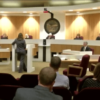Federal forest managers are tangled in their own bureaucracy
Working for the Bureau of Land Management as an initial attack firefighter during my summers in college, you would learn pretty fast how to properly move the hose to quickly fight the flame. During my last summer, our engine had a firefighter on our crew whose only experience was digging lines and not moving water. One night we were trying to quickly catch a growing wildfire but our new crewmate kept getting tangled in the hose.
Federal forest managers seem to be tangled in their own hose reel as they attempt to manage escalating fire concerns. Inundated with too much federal land, overwhelmed with bureaucratic red tape, and heavily reliant on distant oversight, federal forest managers are failing to adequately manage their wildfires. Idaho Congressman Russ Fulcher alongside U.S. Senators Crapo and Risch recently wrote to the U.S. Forest Service Chief Randy Moore saying: “The scale and severity of these incidents can be attributed to inadequate federal preventative measures and delayed response times.”
In the Boise and Payette National Forests, the Lava Fire continues to consume precious public timber resources, amounting to almost 100,000 acres of federal and state-managed land. Even at the end of fire season, nearby complex fires still intensify the severity of the situation, though containment has increased. As of September, the state is facing an estimated $45.8 million bill for wildfire expenses for 2024 (not including the recent fires that burned in October) compared to $14.6 million in 2023.
A portion of this increased expenditure can be attributed to the large fires on federal lands that were not promptly contained and grew into large complex fires. Gov. Little said: “They [the federal government] have got to do more containment, and they’ve got to do more management.” The Idaho Legislature will need to decide in the coming session if they will pre-fund the emergency fire suppression fund. If they choose to not increase funding, the Idaho Department of Lands will need to wait until 2026 for a supplemental request.
Defenders of the federal government’s role as public land managers only need to look at the findings of the Congressional Budget Office to realize that they are poor managers of our forest resources. Less than 1/3 of the fires start on federal lands, but these grow hotter and larger than five times the average size of non-federal fires. Slow containment, poorly managed, unhealthy forests, and excessive lands overwhelm federal managers, and western states, like Idaho, continue to bear the consequences.
First, federal officials need to prioritize quick containment and that can only be accomplished if personnel and experience match the need. In July 2024, federal wildfire managers increased to a Preparedness Level 5, signifying ‘all hands on deck’. But according to reports from on the ground, there were not enough hands to meet the need (despite finally hitting the hiring goal of 101% in July). As of July 2024, 2,417 nationwide requests for necessary fire resources had gone unmet, with a critical lack of experienced firefighters.
In the past three years, the Forest Service has lost 45% of its permanent employees, meaning in-fill into these positions is from firefighters with less experience. A firefighter serving on the fires in Idaho’s Boise National Forest said: “There were not enough firefighters to fill the crews to catch them all. The new fires are all big now too, but hardly anyone is on them.”
Second, under-utilized and poorly managed forests define federal lands in the west, accompanied by the excessive and binding red tape for project initiation. Federal managers need to utilize the best available science to remediate the excessive fuel loads and accelerate management projects. Harvesting is one tool in which the states excel far beyond any federal program. For every dollar spent on federal lands, the payback is $0.73, but states earn $14.51 per dollar spent, with a much smaller land base. Not to mention that new growth of trees is less than half of the number of trees that are dying every year, and harvesting only accounts for 11% of the tree mortality, the rest is attributed to disease and fires. Leaving federal forests to rot or burn is an economic waste and an even bigger environmental tragedy.
Finally, the federal government is overburdened with western land that goes unutilized and unmanaged. The federal government owns 45% of lands in the lower 11 contiguous western states, contrasted with the 4% ownership in the eastern states. Utah’s recent lawsuit against the federal government’s hoarding of unappropriated federal land is a positive assertion that Western lands need the influence of state management and resources, not outsourcing to bureaucratic management on the East Coast.
State officials have demonstrated their superior protection of our forest and wildland resources as the federal government continues to get tangled in its own hose reel. Fires will continue to rage out of control unless the federal government learns from the western states how to properly steward western lands with sufficient and experienced personal, efficient, and scientific forest management practices, and finally by reappropriating land back to the citizens and communities who live and work near these resources.










